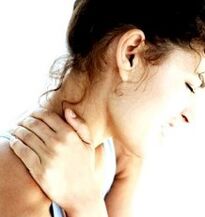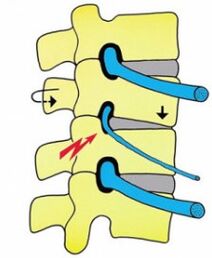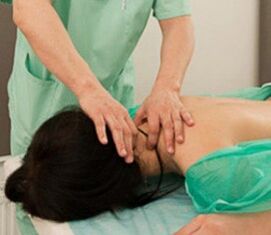Cervical osteochondrosis is a disease that is malnutrition and degenerative disease of the cervical disc of the spine. The cervical department is the most mobile, and the muscle corsets in departments related to other departments are much weaker. The neck performs rotation and inclination of the head, so the spine in this area is affected by deformation, destruction, hernia and curvature formations.

The main causes of disease
Osteocartilage has been determined to be a "young" disease. The disease is now increasingly detected in people aged 18 to 30, and 40 cases were previously considered the norm. The reasons can be distinguished by the following ways:
- Violation of posture, spinal curvature exists depending on the type of scoliosis, spinal advent, or meningitis;
- Overweight, obese;
- Back injury;
- Metabolic disorders, low metabolism;
- Hard physical labor;
- Hypoemia, a sedentary lifestyle;
- Weak physical exercise;
- Nervous fatigue, stress;
- Failed to the health training with athletes;
- a sharp termination of training;
- infectious disease;
- Hypothermia.
Essentially, osteochondrosis is the result of muscle clamps. Muscle spasms eventually stimulate the cervical spine's mobility, destroying the blood circulation, and intensifying the blood supply to bones and muscle tissue. This will cause disaster and the development of malnutrition in the hairy process, and isolate the brain's brain and the nrar brain from each other. Results - Squeeze nerve roots and loss of sensitivity.
Symptoms of cervical osteochondral disease
Cervical osteochondrosis has many symptoms. However, in most cases, osteochondrosis shows affecting the circulatory system. In the cervical area, many blood vessels strongly nourish the brain. Therefore, the risk of osteochondrosis is associated with poor supply of head organs (especially the brain, blood). Signs of cervical osteocartilage degeneration will be affected by the defeated segments. Therefore, the following signs of cervical osteochondral disease were distinguished:
- Root syndrome;
- Cardinal Syndrome;
- stimulating reflex syndrome;
- vertebral artery syndrome;
- Compression of the spinal cord.

If Rooser syndrome is a characteristic, what are the symptoms of cervical osteochondrosis? Ruth syndrome in medicine is called cervical radiation inflammation, which occurs due to clamping of the nerves in the neck. Pain occurs on the neck, entering the area of the shoulder blade bone, and the pain on the shoulder and forearms may be lower until the fingers. In this case, cervical osteochondrosis is characterized by tingling, burning sensation, relief, numbness of the hands, experience of the forearm or fingers.
Symptoms of osteochondrosis in the cervical area will have different symptoms, and the part of the disease will be damaged will affect its differences. If the central nerve and its roots are affected, the paste will be the middle, index and thumb. If the roots of the shoulder nerves are affected, the paste will have a bit of fingers and ring fingers. Osteochondrosis of the cervical spine, the symptoms will have the following syndrome as a stimulating reflex. The main characteristics will be acute, intense, burning pain in the neck and the area of consumption or the neck itself. Pain tends to increase during exercise or load, especially acute in static states. For example, after sleep, the head is incorrect after sleep. Symptoms of cervical osteochondrosis have similarities because as the syndrome develops, pain spreads to the chest. If the injury area is not limited to the neck but enters the segment of the chest, it can be diagnosed. Symptoms show greater cervical osteochondrosis, the largest of which is violation of internal organ work.
Spine Artery Syndrome - Intensified changes in cervical osteocartilage, symptoms show very strong manifestations and are composed of severe pain. Pulsational pain in the temple, the presence of severe migraines, especially the apical, the back and front areas of the head are characteristic. Pain is chronic and constant, but sometimes they record cases of paroxysmal pain. Osteocartilage changes in the cervical spine are exacerbated and express symptoms in the form of increased pain. This occurs after uncomfortable positions, sudden movement, severe physical effort. Intensification can threaten a vestibular disorder due to hearing impairment, ear noise and hearing acuity. Vision problems are not uncommon. Cervical spy symptoms and cardinal syndrome osteochondria disease. The basic syndrome is characterized by severe angina. This makes it difficult to identify the major disease - osteochondrosis. Diagnosis of "osteochondrosis in the cervical area" is usually done promptly because they try to diagnose and treat angina, which threatens the transition of osteochondrosis to a chronic form.

Angina is caused by squeezing the spine in the lower part of the neck, which finds a reflex response. In the case of root or septal nerve stimulation in the chest, the basic syndrome can be manifested. Osteocartilage with cervical vertebrae of matrix syndrome can be manifested in the form of tachycardia, external pulses. Osteocartilage and hypertension in the cervical vertebra often occur. Similarly, symptoms of cervical osteochondrosis are symptoms and their treatment does not always occur in time because the doctor initially diagnosed cardiovascular disease rather than osteochondrosis.
Symptoms and treatment of cervical bone and chondropathy
A certain syndrome is diagnosed from the advantages of certain symptoms, based on this treatment has been performed. Treatment is conducted in two ways: radical, suggestive of surgical intervention or conservative approach. In this case, if the conservative treatment does not give an outcome, an indication of the operation is specified. Osteochondrosis in the cervical area was eliminated by:
- Manual therapy;
- Massage, physical therapy procedures;
- Reflexology - Acupuncture;
- medical, pills;
- water course;
- Folk treatment methods;
- LFK courses and healthy gymnastics.
Tablets for treating cervical bone and chondropathy symptoms
Usually, prescription medication is treated in situations where symptoms include severe pain. In fact, pills are not the cause of pain – the magic pill for osteochondrosis itself. If the temperature of osteochondrosis in the cervical spine increases, a tablet is also prescribed. This symptom indicates an inflammatory process in the body, and inflammation in tissues and nerves must be eliminated.

Cervical osteochondrosis, symptoms, treatment and gymnastics
An effective and affordable treatment is considered the complexity of exercise therapy and gymnastics exercise. The purpose of exercise is to increase flexibility of the cervical spine, increase the distance between discus, and enhance the muscle corset that can protect the spine from injury and damage. Similarly, gymnastics and exercises are very effective in establishing the function of the circulatory system, which not only promotes bone tissue, but also allows us to allow blood to flow to the brain. The most important thing is to practice under the supervision of a doctor.
Cervical osteochondrosis, symptoms and surgical treatment
If conservative treatment does not yield results, the operation is prescribed. It provides removal process, removal of arches and ligaments, and hernia falling into the spinal canal. After this process, cases of total instability in the cervical region are not uncommon. After the operation, a special support collar was opened to the patient, which stabilized the weak neck and temporarily supported it.
Usually, if you diagnose the disease promptly, hold the strict advice of your doctor and perform a comprehensive conservative therapy, osteochondrosis will be significantly adjusted and in many cases, pictures of complete recovery are observed.
























